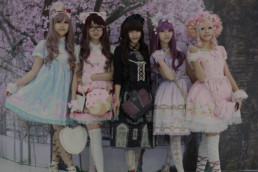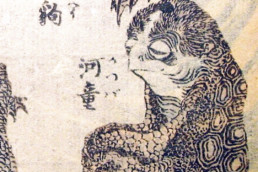Japanese Culture: Ramen
Ramen: “The emperor” of Japanese cuisine.

Photo credits: narutonoodle.com/
Until a few years ago, for ethnic cuisine enthusiasts, going to a Japanese restaurant strictly referred to taste Sushi: a dish made of raw fish and rice.
This dish, with its colorful and evocative shapes, winks at the most fashionable diners (but not just them!), who have the opportunity to taste "first with their eyes than with their mouth". But now another famous dish in Japan has finally made its way to our tables, with many people going crazy about it.
We are talking about Ramen (ラーメン,拉麺 rāmen), perhaps the real representative dish of the country, and so famous throughout Japan that each region boasts a different way to prepare it. Different region, different recipe. Let’s taste them all then...
A soup with many ingredients: Chinese noodles, pork, Nori (海苔) or dried seaweed, boiled eggs, and the kamaboko. Mainly known as surimi. Its most famous form, the spiral one, is called Naruto (like the manga character of the same name whose name derives from this ingredient). It can have fish or meat broth, various garnishes and different ways to flavor it, with sesame seeds or pepper for example, miso or soy sauce.
Story of a Soup

Photo credits: travelcaffeine.com
Although it is unclear when the spread of this plate began in Japan, the origin is Chinese as one of its main ingredients are the Chinese mian or Chinese wheat noodles. But we must say that only in recent years there has been a revival in China, as ramen is no longer considered a traditional dish but a Japanese imported product. In China, they are called rìshì lāmiàn or "Japanese style Lamian".
Ramen has always been a dish to be enjoyed outside and at the beginning of the 20th century there were numerous kiosks with Chinese handlers. Then, after the Second World War, Japanese soldiers returning from China, where they had learned this culinary tradition, opened several restaurants across the country. From that point on, there has been an evolution that led to ramen as we know it today.
It is so appreciated that in 1994 the Shin-Yokohama Raumen Museum entirely dedicated to this delicacy was opened in Yokohama .
‘Company’ Ramen.
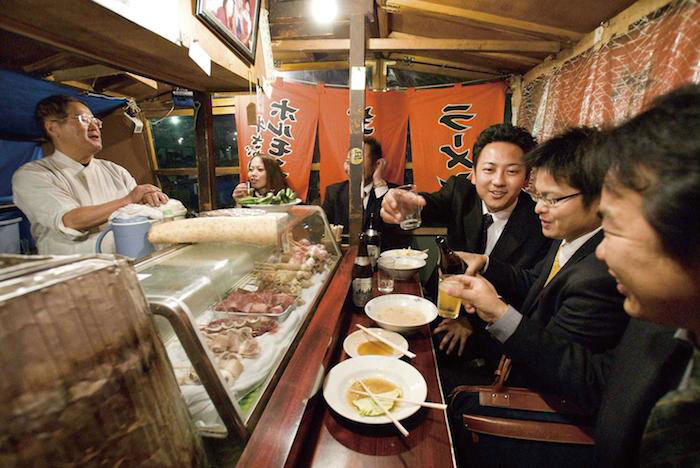
Photo credits: jpninfo.com
As previously mentioned, in the past it was not so strange to taste ramen bowls in street stalls, which are still popular today, though not so very widespread. This is because ramen is also considered a street food to be enjoyed in traditional Yatais or stalls. On the other hand, the best restaurants are the Ramen-ya with just a few seats at the counter and at the tables as well, but with the purpose of eating ramen only. And it is not unusual to find ramen in amusement parks or in karaoke's menus. It may also happen that after work colleagues stop by an Izakaya, a pub with the formula Nomihodai "all you can drink" - Tabehodai "all you can eat". Here, with a limit of three hours, diners can enjoy ramen together with liquor and other foods with fixed-price menu.
Honorable mention and regional variants

Photo credits: zerochan.net
Although the classic recipe is common throughout Japan there are always innovative variants.
Here we have to mention the Blue Ramen, of a beautiful and brilliant color, and we want to specifie this, it is completely natural! But this is an extreme innovation.
“Traditional” regional variants are:
- Tokyo variant, with thick noodles, chicken and soy broth, garnished with bamboo shoots, shallots, sliced pork, seaweed, spinach, an egg and a little bit of Dashi. We recommend you try shops in Ikebukuro, Ogikubo and Ebisu wards.
- Sapporo is famous for the "winter" version, sometimes garnished with seafood, butter, pork, corn and bean sprouts.
- Yokohama has the le-kei , coddled eggs for which each customer can choose the desired softness and then break it so to flavor the broth, also adding onion, pork, spinach and seaweed.
- Kitakata with its thick but flat noodles served with pork broth.
- Hakata and its broth made of pork bones, thin noodles, ginger, vegetables, mustard and sesame seeds.
If reading this article made you really hungry we want to recommend some places where you can taste ramen in Italy:
Nozomi
Via Pietro Calvi 2, 20129 Milano, Italia
+39 02 7602 3197
http://www.nozomi.milano.it/
Casa Ramen
Via Porro Lambertenghi 25, Milano, Italia
+39 02 3944 4560
https://www.facebook.com/casaramen
Zarà Ramen
Via Solferino, 48, 20121 Milano, Italia
+39 02 3679 9000
https://www.facebook.com/zazaramen/
Mi-Ramen Bistro
Viale col di lana, 15 | Viale Col Di Lana, 15, 20136, Milano
+39 339 232 2656
http://mi-ramenbistro.it/
Osaka
Corso Giuseppe Garibaldi 68, 20121 Milano, Italia
+39 02 2906 0678
http://www.milanoosaka.com/
Ryukishin
Via Ariberto 1, 20123 Milano, Italia
+39 02 8940 8866
http://www.ryukishin.it/
Banki Ramen
Via Dei Banchi 14 Rosso, 50123, Firenze, Italia
+39 055 213776
Waraku
Via Prenestina 321/A, 00177 Roma, Italia
+39 06 2170 2358
https://www.facebook.com/Waraku-192626757583758/
Japanese Folklore: The Ring
Ringu: The cursed tape

Photo credits: Movieweb.com
The Ring is the fortunate American horror movie with Naomi Watson in the role of the protagonist that in 2002 haunted cinemas all around the world. Earning more than $250 million dollars at the box-office it revived a suffering genre giving the bravest spectators shivers. The movie had a sequel, The Ring 2 out in 2005, and The Ring 3 recently came out, fifteen years after the original movie.
Samara Morgan is a little girl with long raven hair and snow-white skin, and from this description she might appear like a pure Snow White. But reality is quite different. With her famous words “You will die in seven days” she is a ghost that brings to death all those who watch her cursed tape thanks to an infinite ring.
Nowadays, Samara is among the ultimate ‘villains’ of the American horror genre (together with Jason from Friday the 13th, or Freddy Krueger from A Nightmare on Elm Street with his supernatural and demoniac nature). And we might as well say she is one of the many possible Halloween masks.

Photo credits: flickr.com
However her birth is not American but Japanese, as she was born from the pen of the writer Koji Suzuki author of the novel of the same title Ring ( リング Ringu). Suzuki is also the author of Spiral, one of the sequels of The Ring, and Dark Water which gained a movie and an American remake. Here the protagonist is Jennifer Connelly and it's undoubtedly a terrifying movie, yet unable to reach the fame of The Ring.
The American Remake of The Ring in not so different from the original subject (This is true at least for the first movies). In both films the protagonist is a journalist that is trying to solve the mystery behind the inexplicable deaths caused by the viewing of a cursed videotape. The woman will end up involving her family in this spiral, in a desperate run for their lives. But the ghost is not that of a disturbing child now, but that of a young woman.
Sadako 貞子

Photo credits: Movieclips.com
Sadako is the ghost of a nineteenth years old girls with long hair that cover her face completely and that coming out of the television brings the unfortunate person to a violent death.
This ghost is in reality a very complex creature, like all Japanese ghosts, as their cruelty is driven by nothing but revenge. Unfortunately, when the mission of seeking vengeance from those who had hurt them in their human life is accomplished, hatred has already taken over. Every possibility of redemption gone.
Sadako Yamamura was her human name and in each movie we have an insight into her story discovering something about her character. But it's in the prequel of the first story-line, The Ringu 0:Birthday, that we have a complete vision of her human life.

Photo credits: anythinghorror.wordpress.com
Before she became the restless ghost that characterizes the whole story, Sadako was born from a forbidden intercourse. Her father unknown, he was said to be a demon, her mother was a priestess devoted to dark arts. Since her childhood she was harassed by voices saying that being close to her brought misfortune and death because of her enormous but dark powers. She could have had a little light of hope in a tormented life when she moves to Tokyo with professor Ikuma. The professor, her mother’s ex-lover, treats Sadako as his own daughter and reached adulthood she joins a theater company. Here, due to a series of tragic events she becomes leading actress, but this also led to the rise of her evil part.
In fact, we will find out that there are two entities inside her, the human part that is good, and the demoniac part with the appearance of a child. The abuses she suffers and the death of her good part by the hands of her colleagues will bring out her demoniac side, with the consequent series of tragic events.

Photo credits: noset.com
Ikuma will try to kill the evil Sadako too, trowing her in a well and sealing it, but the entity survives the fall even if it is now imprisoned. Inside the well the demon will grow stronger and stronger until its hatred takes concrete form in the cursed video tape that in seven days leads to death whoever watches it.
But in spite of all this we can’t help but pity here, miserable soul. In her last moment of human lucidity, before her demoniac side takes over, she remembers of Toyama the only man she had ever loved.
The movies have a substantial differences from Koji Suzuki’s books regarding the story of this character as the young girl has an even more tormented and complicated life, ending with her fatal death.
Banchō Sarayashiki 番町皿屋敷

Photo credits: Wikipedia
The character created by Koji Suzuki, like many other of the Japanese modern horror genre, takes a cue from an old legend.
We are speaking about the story of Okiku and the nine plates. The Kabuki theater has often used this legend for its representations and there are many versions of it.
The protagonist is always Okiku a young and beautiful servant that works for the family of a samurai, Aoyama Tessan, that is in love with her. Countless times the girl refuses the samurai’s approaches, so to induce her in temptation he makes her believe she had lost a precious porcelain plate part of a set of ten. The poor girl desperately cries because she knows that the punishment will be severe, but the samurai comforts her saying that in exchange for her love she won’t be punished. Okiku still refuses him and the samurai blinded by rage pushes the girl into a well killing her.
Okiku comes back as a ghost to torment her assassin and keeps counting to nine and then start crying. Only a monk and exorcist is able to purify her spirit during one of her appearance. After he had her count to 9 the monk screams TEN!,in this way the spirit is free and ready to go to heaven.
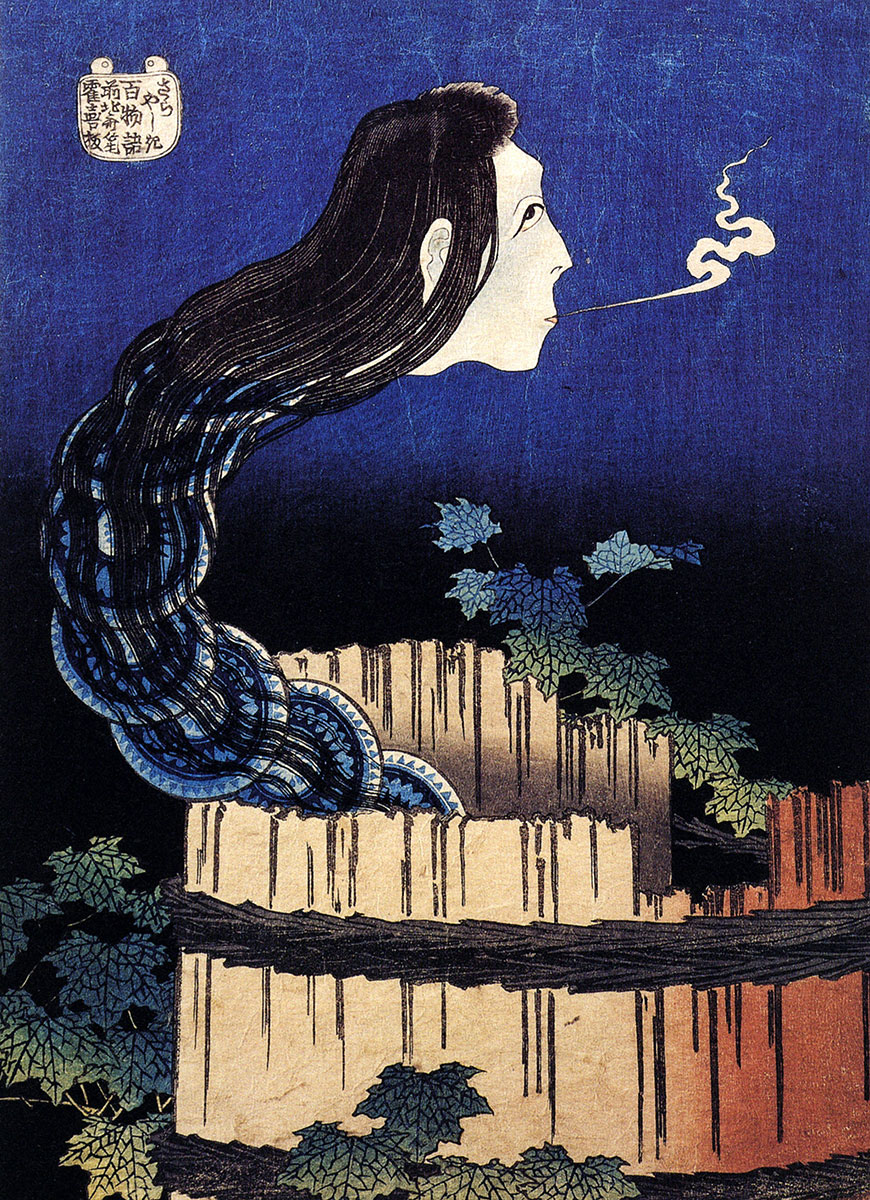
Photo credits: Wikipedia
As we said, there are many variations to this story, more or less similar to each other. In one of them the story takes place in the Himeji castle where Okiku dies because of a conspiracy within the court, or because the shogun, her lover, kills her because she voluntarily breaks the tenth plate.
Anyway, in every version we are brought to pity this character, surely obscure but tormented at the same time.
Japanese Culture: Lolita fashion
Lolita fashion - (ロリータ・ファッション Rorīta fasshon)

photo credit: mangakas-onfire.blogspot.it
Probably, those who have a romantic vein suspended in an undefined past, would like to be like a beautiful porcelain doll. Maybe they would like to have lovely dresses that would rival those of Marie Antoinette ad go to a dreamy Tea Party.
All this things are possible thanks to the Lolita phenomenon, one of the most famous and sophisticated Japanese trends. As a mix between Baroque and Victorian style, it is really appreciated in its home-country but is also known all around the world.
The name refers to, although it doesn’t celebrate, Vladimir Vladimirovič Nabokov’s novel, but this trend is not a tribute to a young and provocative sensuality. In fact, it represents beauty that hides innocence, the elegance in hiding more than showing. Moreover, the name ‘Lolita’ is a Wasei-eigo, a word that includes all those anglophone words that in their original language have a completely different meaning or don’t even exist, but that are part of the Japanese vocabulary.

photo credit: honoluluacademy.org
It’s not certain when this type of clothing was created. Some think in late 70’s, although it is true that it become popular by the end of the 90’s. This trend was greatly influenced by the musical genre of Visual Kei. It is no coincidence that this type of music is really theatrical not only in its sound but also in band members’ dresses too.
Exemplary are MALICE MIZERE partly thanks to their co-founder and leader of the band Mana (also called Mana-sama by his fans). In particular Mana influenced the “Gothic Lolita” also signing his own brand Moi-même-Moitié.

photo credit: pinterest
Gothic Lolita and Sweet Lolita

photo credit: my-lolita-dress.com
The Lolita Style is divided into two distinctive trends (also divided into many sub-styles) : The Gothic Lolita, maybe the most famous one, and the Sweet Lolita.
The GothLoli (ゴスロリ gosu rori): The Gothic Lolita as we said is probably the most famous type but its name is erroneously attributed to the whole genre. Black is the dominant color celebrated in all its possible shades. But it doesn’t disdain other dark colors like burgundy, dark blue, violet, and emerald green. These colors are often used in both cloth and make-up with heavy and dramatic smokey eyes and lipstick that stand out on the white powder. In fact, this is the only exception to the Lolita style in which this type of powder is used because in all the other styles a more natural look is preferred. The dense embroideries of the clothes are inspired by grim stories with their skulls; or religious themes with crosses (gothic crosses) used in jewelry too. Coffins are used as small purses and small black lacy umbrellas refine the outfit.

photo credit: pinterest
The Aristocrat Style is one of the many sub-genres of the Gothloli but is more mature and somber, as its name suggests, purposely more “aristocrat” and very elegant.
Since the Gothic Lolita style is based on the Victorian Style, that as we remember is emblematic of the Gothic and the refined, we have to take notice of the similarity with the western steam-punk.
Ama-loli (甘ロリ ama rori) : the Sweet Lolita on the other hand prefers pastel colors and especially pink. The same goes with make-up here less dramatic, almost more natural. Nevertheless, it still remains an elaborate style, especially emphatic on the eyes with light shades of pink and fake eyelashes for doll-like eyes, as well as light nuances for the lips. This style too is inspired by the Victorian Age but even more it is influenced by French Rococo. This is a more ‘child-like’ lolita style, were ribbons and bows are dominant. The embroidery are inspired by the world of fairy tales, unicorns and small miniature french sweets like Macaron. They are jewels to show off together with small rucksacks with the shape of small bears or rabbits and the inspiring heroine is “Alice in wonderland”.

photo credit: pinterest
Sub-genres and the Prince
The world of lolitas is various and elaborated, there are genres to suit every taste. The Wa Lolita is a mix between lolita clothes and traditional kimonos, with a Obi around the waist and the classic Geta as shoes; The Qi Lolita, that comes back to the Chinese style where instead of kimonos it modifies Chinese qípáo; The Sailor Lolita is based on the classic sailor uniform with its more elaborated variation; or the Pirate Lolita.
And if you think that the Lolita style is all “Sugar and cinnamon” we also have the Guro Lolita. Here lolitas are inspired by the horror genre with fake blood standing out on pure-white dresses to give the idea of broken porcelain dolls.

photo credit: pinterest
But there are really a great number of examples we could speak about.
A particular note must be given to the Ōji (王子 prince) Style for all those that think that the lolita style is only a girl’s trend. The Prince style is based on models of clothes used by young Victorian Dandies, so here we have short trousers and knee socks. But this doesn’t mean it is a men-only style. If a girl would like to get close to the lolita world and wanted to have a more androgynous style this is the right choice for her.
Must-have, various Brands, animes and influence outside Japan.
There are some cult objects that every Lolita with this name must have in her wardrobe: the Cutsew, blouse with big blows and puff sleeves or the Petticoat, the undergarment used to give a larger shape to skirts and dresses.
For those who would like to know how can lolitas have such beautiful and thick hair… well you must know that it is a wig.
Lolitas embellish them with big ribbons and Bonnets too, the typical small hats used in the past, and this goes together with iconic shoes in a Mary Jane like style. Even if these shoes for kids come from the past century they are the shoes that every Lolita wears.

photo credit: pinterest
Aside from that of Mana-sama, other popular brands are Angelic Pretty, e Baby, The Stars Shine Bright, this last one with boutiques not only in Tokyo but in Paris and San Francisco too.
We must say that the lolita fashion is very expensive, but there are Indie brands
as beautiful as the most famous one that are certainly less expensive. And in Japan there’s the possibility to buy lolita clothes in department stores too, or there are dedicated web sites that sell second or third hand clothes. In other words it is a style open to everyone.
The Lolita phenomenon found its way to many successful animes too.
Some examples are Paradise Kiss by Ai Yazawa better known as the ‘mother’ of Nana; Princess Princess, where the lolita fashion is seen through the eyes of three boys; Le Portrait de Petit Cossette, female and Noir version of the Portrait of Dorian Gray; and Rozen Maiden too, where the protagonists are precisely beautiful dolls.
As we said, Lolitas are famous not only in Japan but we can meet a great number of small communities from America to Europe.
Lolitas gather together in refined Tea Houses to celebrate the 5 o’clock tea with the class and the style that distinguishes them from any other trend.
Japanese Folklore: Kappa
Kappa or “Son of the river”
A Kappa is a funny chimera, its true appearance is still unknown, a bit human a bit monkey-like. But most of the times it is depicted with the face of a tortoise with a yellow beak. From tortoises it borrowed the shell and the scaly skin with its watery colors, usually of a nice seaweed-green. On the head it carries a lotus leaf containing water, and it is from this water that it draws its powers. This is the Kappa (河童) or, if you like, you could call it Kawatarō ( "boy of the river") or Kawako ("son of the river"), you will make him happy.
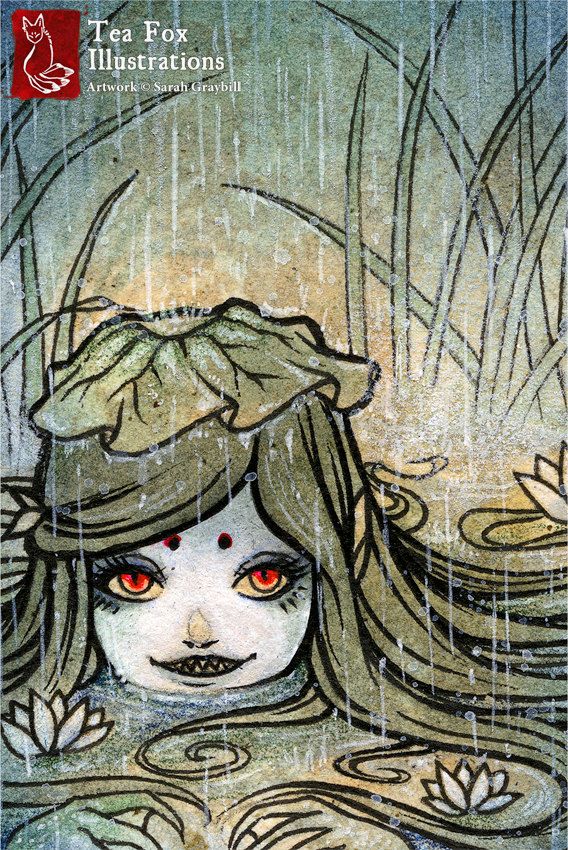
Born as a warning to scare kids away from the dangers lurking into deep waters, they are Shintoist Suijin (水神 "water god"). However, generally speaking these mythological figures are one of the many Yōkai (demons or phantoms) of the Nipponic folklore.
As much as its appearance may arouse your mockery, the Kappa is not the type to make fun of because it is a mischievous and naughty creature. In the past it was said that he abducted children because it is a glutton for them, but didn’t say no to adults bowels. They are always ready to do mischievous pranks from pulling the kimono of young girls to stealing the harvest of farmers.

Even if it is naughty and somewhat dangerous, formalities are a good way to be safe with it. That’s right, it is a very polite creature even if it seems hard to believe. The Kappa loves good manners and if you make him do a good, deep bow, it will spill its magical water and lose all its powers. The Kappa is also a creature always ready to stick to its word and to give rewards. If you find a Kappa in difficulty help it by pouring water on the leaf on its head, it will be indebted to you for life! Maybe you would like to have one of them as a friend? Well, I said nothing but Kappa love cucumbers! Yes! Offer this fresh vegetables to a Kappa and it will reward you with its friendship. And well, who wouldn’t like to have one as a friend nowadays?
Usually, they live in lakes and deep ponds and this is why they are skilled swimmers. But here we must say “kappa no kawa nagare”, "a kappa drowing in a river" , because even the most skilled make mistakes, so never give up!
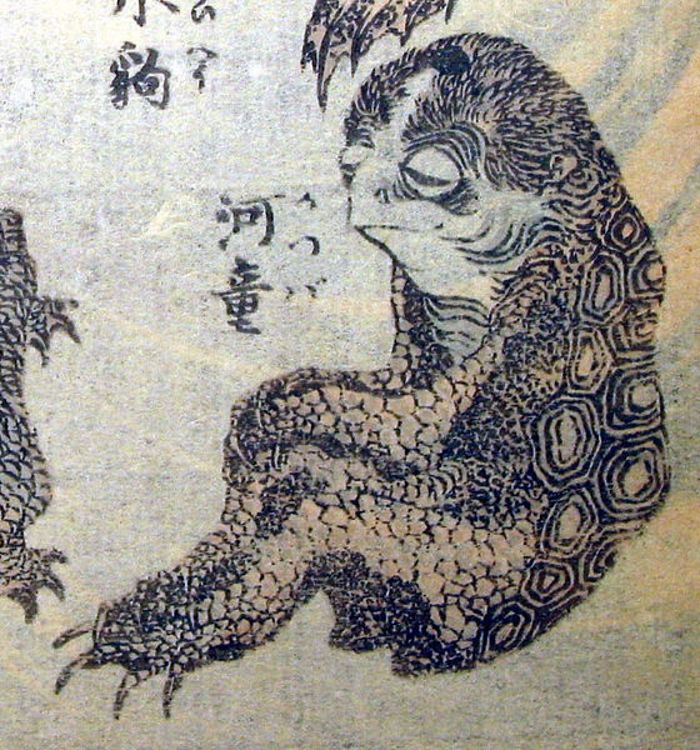
Nowadays they are not as feared as in the past, they have become somewhat more “Kawaii” and a great number of animes take a cue from them. In Marmalade Boy the two main characters Miki and Yu have a Kappa plush as their mascot; different Pokemons were inspired to this creature and Kappa no Coo to Natsuyasumi (Summer days with Coo) is the story of the friendship between a kid of our days and a Kappa looking for its fellows.
Even J.K. Rowlong wrote about this mythological creature in her book Fantastic beasts: where to find them. And if you are interested in seeing a real one, or at least what is left of it, you would like to go to Asakusa, Tokyo district. In the Buddhist temple Sogen-ji you can worship its remains.
photo credit: manganews, wikipedia, facebook.com/TeaFoxIllustrations
Japanese Culture: Shingeki no Kyojin
SHINGEKI NO KYOJIN – The revelation of the past few years
This time we will talk about Shingeki no Kyoujin (進撃の巨人), translated in English as Attack on Titans, the revelation of this past few years.
It's an action horror shōnen manga series already recognised as a cult among anime and manga fans. For those who don't know it, it is enough to know that in just a short period of time it was able to climb up all charts, Japanese ones and worldwide too. It became one of the most viewed anime around the world, and its original manga ranks second in numbers of sold copies, second only to One Piece.
To give you some numbers, we talk about around 2 million copies per volume (Japanese sales), while One Piece sales are around 3 million copies.
This results are even more incredible if we consider that One Piece has many years of releases already (the first volume was released back in August 1997). On the contrary, the first volume of Shingeki no Kyojin was release only in September 2009. This numbers are enough to make your head spin, and contributed to let this manga gain the prestigious Kodansha Manga Award in the shōnen category in 2011, to say the least.

Plot
The original manga is published by one of the largest publishing companies in Japan, the Kodansha Publishing. It counts 21 volumes up to today. It was created by Hajime Isayama and the story, and it takes place in an alternative Midldle Age era. The plot revolves around the character of Eren Jaegar. He lives in a world that many centuries before had been on the verge of destruction. The few humans that survived now live in a urban complex built inside three concentric walls, 50 meters each. The only protection between mankind and the outside world overrun by mysterious creatures are the titans.
This titans resemble human beings but they can be from 3 to 15 meters tall, apparently thoughtless and with the sole objective of devouring human flesh. However, an unexpected event will bring this period of peace to an end. A titan so tall that he could even surpass the walls, appears from nowhere opening a hole in the most external wall. This allowed other titans to break into the city and leading to the massacre of many human lives.
Eren, after regaining his senses because of the loss of his mother by the hands of a titan, swears to eliminate every single titan in the world, and he will not be alone in this fight against the unknown.

Anime adaptation and international recognition
This series gained its worldwide success thanks to its anime adaptation, produced by Wit Studio in collaboration with the famous Production I.G, that was release in 2013.
The difference with the original panels of Isayama in terms of visual impact is astonishing: with an incredible attention to even the smallest detail, and animated by an extremely realistic animation, all the characters take their actions on a background equally elaborated and realistic. The producers of the animated series filled the holes in terms of style left by the mangaka. He also followed the whole production, giving advice on which was the best way to give shape to his ideas.
The original soundtrack skillfully created follows the whole narration. It never fall silent, it never leaves open spots. Instead, it contributes to underline every instant of the story and envelopes the viewer in an action anime full of twists and turns.
Action, horror elements, political intrigues, religious fanaticism and the fight for survival create the background. Here well delineated characters take their action, in a crescendo of action and suspense, showing us both the strength and fragility of human beings.
Nothing has been left to chance. Even characters that apparently look not so important will be proven to have a fundamental role to play.
The horror element is skillfully balanced, it doesn't exceed into pure violence, searching for the smallest gory detail. All this makes the animated version even more enjoyable and appropriate even for people who don't really like this genre.

Interpretations
This series is open to many interpretations, someone even wanted to read into it a sort of political propaganda. However, the author himself gave us some keys to understanding the genesis of the story.
For examples, the 3 walls in which mankind survives, can be seen as both a protection and a suffocating prison. This is the exact same feeling that the Isayama experienced living in his hometown in Ōita prefecture surrounded by mountains. And it is clearly visible here a parallelism with Japanese society, generally known to be isolationist and enclosed.
Furthermore, the titans represent the fear of the unknown, an unknown that you can't even communicate with.
At times the story makes you experience a feeling of overwhelming anguish and fear. The same feeling that is so common in our modern society where nothing is what it seems, but all the characters never stop fighting in their quest for truth and freedom.
深い闇を俺は抜け出した。疾風(はやて)みたいに逃げ出した。
Fukai yami wo ore wo nukedashita. Hayate mitai ni nigedashita.
We broke out of the thick darkness. We escaped from what seemed like a hurricane.
生きた屍みたいだった俺達は、壁の外へ。
Ikita shikabane mitai datta oretachi wa, kabe no soto e.
We, who look like living corpses, are going outside the walls.
また会おうぜ、地図にない場所で。
Mata aou ze, chizu ni nai basho de.
Let's meet again, in the unmapped place.The grate escape by Cinema staff – Second ending
What's next?
The plot hides a secret that is still unknown but you might want to know that the original manga has now entered the final arch so, important truths might be unveiled very soon.
In a moment that some would call of stagnation for the Japanese animation, Shingeki no Kyojin was able to impose its originality, and Isayama created a distinctive style of his own. And this originality was rewarded with the great success in terms of fans that it had and that are still increasing.
Moreover, another good news for all affectionate fans that were kept waiting since 2013: after many denial ad postponements, 3 ova, and a lot of patience of the fans, it was finally announced that the first episode of the second season of the anime will be aired on April 1st (April's fool? Doesn't seem to be the case). The wait is over.
[:]
Japanese Folklore: Pretty Guardian Sailor Moon
Pretty Guardian Sailor Moon

If I tell you that her hairstyle is famous all around the world for its blonde pigtails tied up into cute Odango (lit. Meatballs) can you guess who I'm talking about? No? Her outfit is a mix between a school uniform and a sailor's one and it doesn't ring any bell? No, this is impossible because we are talking about Usagi Tsukino.
She universally known as Sailor Moon the warrior in a sailor uniform that protects the Earth from evil aliens from all around the galaxy. Beloved heroine among children from the 90s and one of the ambassadress for Tokyo’s Olympic games in 2020.
Born from the sublime work of Naoko Takeuchi, at the beginning of the 90s, it immediately became and iconic character both in Japan and abroad. Triggering dreams of generations of people with her immortal love story with Tuxedo Kamen and teaching the values of friendship together with her companions of adventure, the Sailor Senshi, she is legend today still.
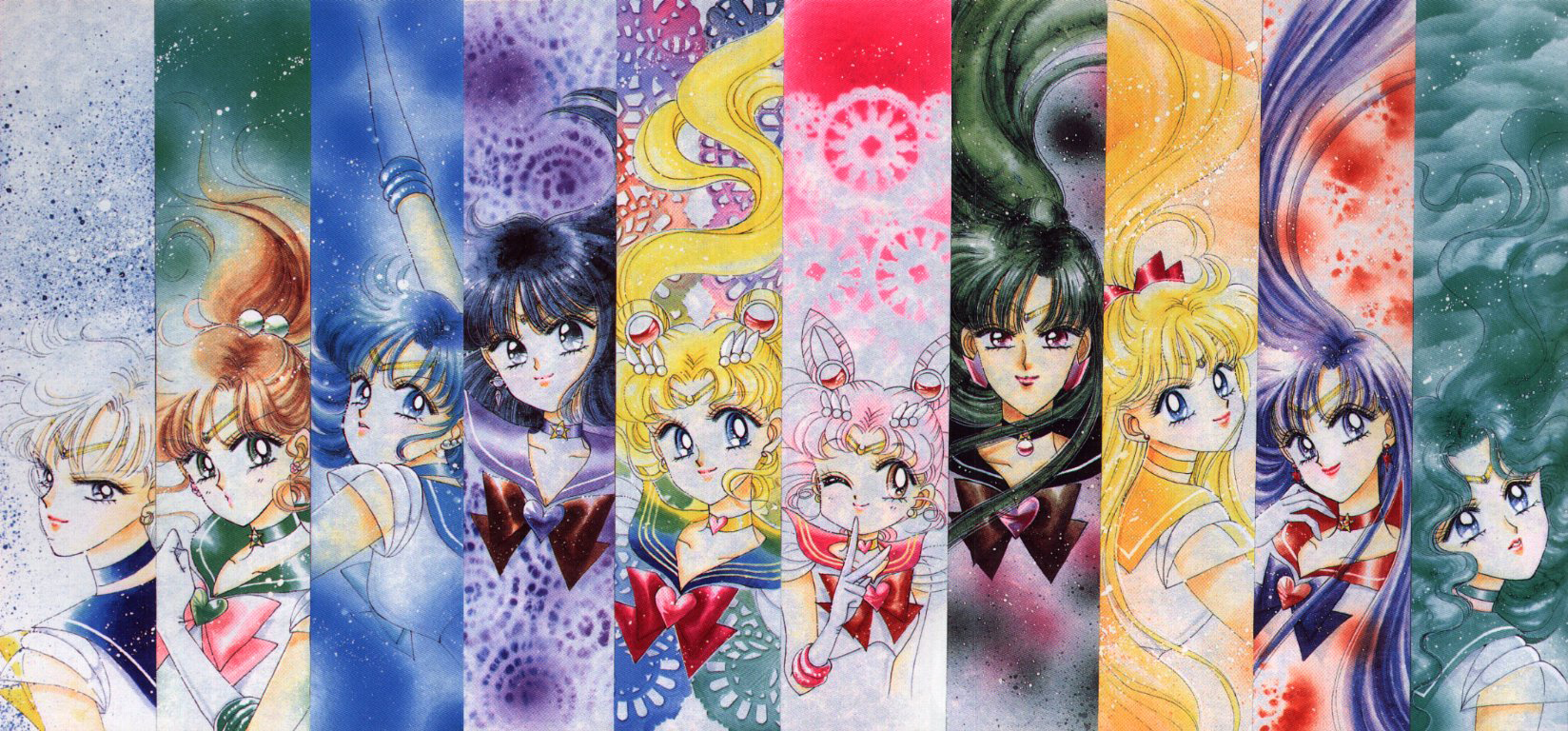
The origin
Sailor Moon was originally created to be the spin-off of Codename Sailor V. Yes! Our heroine from the moon was born after her companion Sailor Venus, true leader of the Sailor warriors. This manga represents the best example of Majokko (魔女っ子 "Magical girl"), that is a sub-genre of the shōjo genre. The typical plot for this genre tells the story of a magical girl supported by a magical animal. In our case we have three cats, Luna, Artemis and Diana. Usually the protagonist of this type of mangas has magical powers, mixing love and fantasy. However Sailor Moon is also the first female version of the genre Sentai Mono (戦隊モノ "fighting squad"). This is a genre that includes all those mangas in which a group of protagonists stick together and fight against evil forces.
So it is no surprise that Sailor Moon is, for this and other reasons, one of the best examples of Feminism in the manga world.
Love beyond time, space and genre
Sailor Moon not only taught us the values of friendship, but it also had a great impact on love, free from any generalizations for categories, as it often happens in mangas and even in real life.
We all know that the most known couple in the manga like in the anime is that formed by Sailor Moon and her Tuxedo Kamen, a love beyond time and space, hence immortal.
In love since their previous life, Princess Serenity and Prince Endymion form Earth, they take their names from the Greek moon goddess, Selene, and her beloved prince from Earth, Endymion. From the legend to reality, they love each other even in their present life as Usagi Tsukino and Mamoru Chiba, as they will love each other in the future too as Neo Queen Serenity and King Endymion.

One might think that is Tuxedo Kamen that rescues our heroine when she is in danger with his flying roses, but it’s his character that many times falls in the hands of the enemy, even becoming evil himself at some points. However, it’s only thanks to the love that Sailor Moon has for him that he manages to survive and with him, all us humans. Because as Takeuchi said “Girls have to be strong to protect the man they love”.
Sailor moon and the homosexual relationships
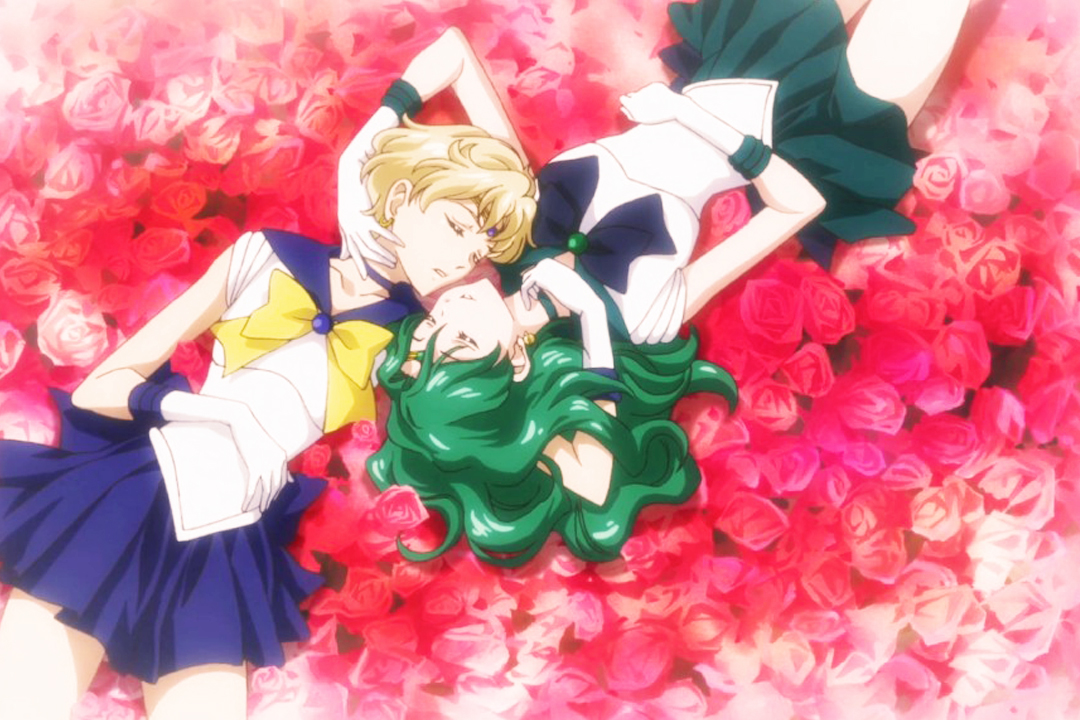
But there are also other love relationships in the manga. The sapphic and unconcealed relationship between the androgynous Sailor Uranus and the sensual Sailor Neptune. A relationship that is somewhat veiled but that is clearly visible from the third act on.
Also, there's the homosexual relationship between two emissaries of the Dark Kingdome. Zoisite and Kunzite's relationship changed from version to version. Love in the animated series and strong friendship that never becomes love in the manga.
But we can also mention the strong bond between Sailor Mars and Sailor Venus, that reminds us of the bond between Mars and Venus in the ancient myths.
Naoko Takeuchi: an empire among stars, art and style
The ‘mother’ of our beautiful sailor warriors is, as said before, Naoko Takeuchi, born in 1967. It is as if she won the lottery of life in the world of mangas. Not only her most famous work is well known all around the world, but she also married Yoshihito Togaki, ‘father’ of Yū Yū Hakusho and Hunter x Hunter.
Also, she is close friend with other famous mangakas like Wataru Yoshizumi (Marmalade Boy) e Yuu Watase (Fushigi Yûgi).
The passion for drawings has always been with her in spite of the fact that she studied chemistry in University. Her style is characterized by clean and delicate lines, that are particularly lovely in the art book with doilies as decoration.
She is a woman of many passions, from literature, to cars, arts and many other things. In many cases she used the Art Nouveau works of Alfons Muchas as references for her illustrations. Another great passion of hers is fashion, various outfits used by Sailor warriors and their enemies were inspired by Maison Dior. The wonderful and iconic gown worn by Princess Serenity is inspired by Dior’s “palladio” gown from the ‘92 spring/summer collection.
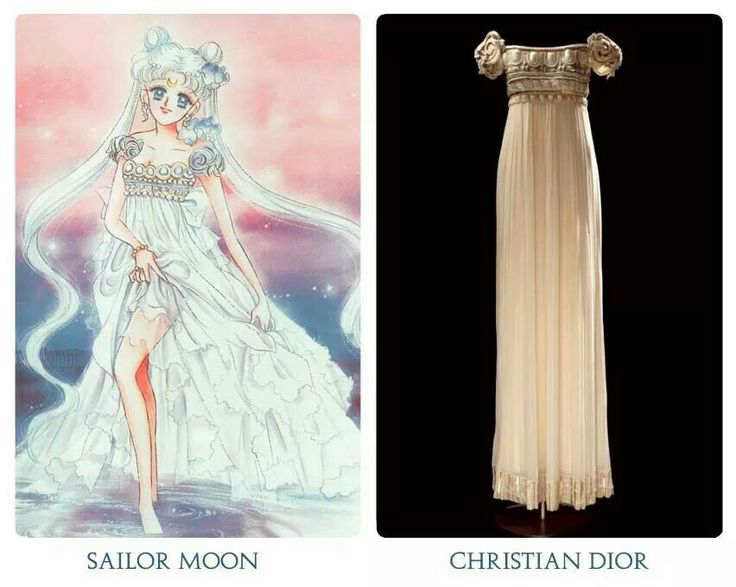
Thanks to its 20th anniversary, and now to its 25th anniversary, Sailor Moon shines brightly under a new lucky star. True happiness for all those kids that grew up with her and now have turned into grown up collector.
Sailor Moon Franchising
The Sailor Moon franchising goes from the classic dolls, to the most varied action figures. There are also countless make-up products, lots of cult objects like the replica of the Moon Stick, outfits and many things more.
The manga was adapted into a live action series, several OVAs, musicals and let's not forget the new anime adaptation of Sailor Moon Crystal released on July the 5th, in 2014.
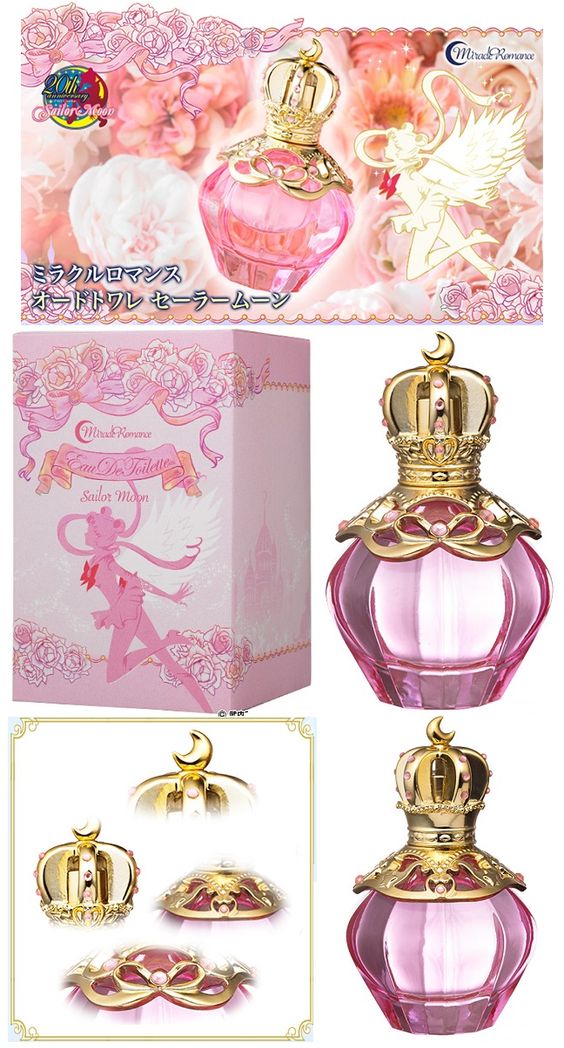
In Tokyo a theme bar was opened and remained active for some time. For all those that couldn’t go there, you can always visit the Azabu Juban “shopping district”, central district in Tokyo. This area is often shown in Sailor Moon’s frames. For every true fan this is a must if you want to feel like a real Sailor Warrior.
Photo credits: Tumblr, Pinterest.
Japan Folklore: Kitsune
Kitsune (狐)

The fox that always comes back
Kitsune. Clever, sly, with a beautiful fur the color of the Autumn leaves, a thick tail and a lovely face that makes them look like they are smiling. Foxes are in many cultures associated with slyness, but in Japan they have something more. In fact they have something magical and mysterious.
In the Japanese Folklore the kistunes are spirits in possession of great powers. They have fire breathing, they can create lightnings and can also enter people’s dreams. They can have a really long life and their powers grow stronger as they grow older, and so do their tails, that go from one, to two, three, up to nine of them. Their fur changes to become white (or sometimes gold), but according to some legends it can also be black.
The Powers
The kitsunes are famous for having shape-shifting powers. There are a great number of legends where these creatures take the shape of beautiful and charming women that make the fortunate or unfortunate man fall in love with them. They are ambivalent beings, on one side they are lovable lovers, on the other side they are mischievous creatures. In fact, there are different types of kitsunes.
The Zenko Kitsune (善狐 "good foxes") are the foxes that follow Inari, the Shinto deity of agriculture, harvest, rise and fertility. They are benevolent spirits and meeting one of them can only bring good news. On the contrary, the Yako Kistune (野狐 "foxes of the fields", o nogitsune) are mischievous and even evil. In contrast with the Zenko Kitsune, the Yako bring misfortune with their powers and can even posses people. The unlucky men that fall for their tricks are called Yako-tsuki and this possession makes them look they are lunatic. In the past it was said that people were possessed by these evil entities in order to find a justification for many mental illnesses. Sometimes the encounter with one of these spirits could bring to death.
They are not only intelligent but also wise. This wisdom increases with time, like their powers do, until they become omniscient. They know everything about this world, they know the past and what will happen in the future.
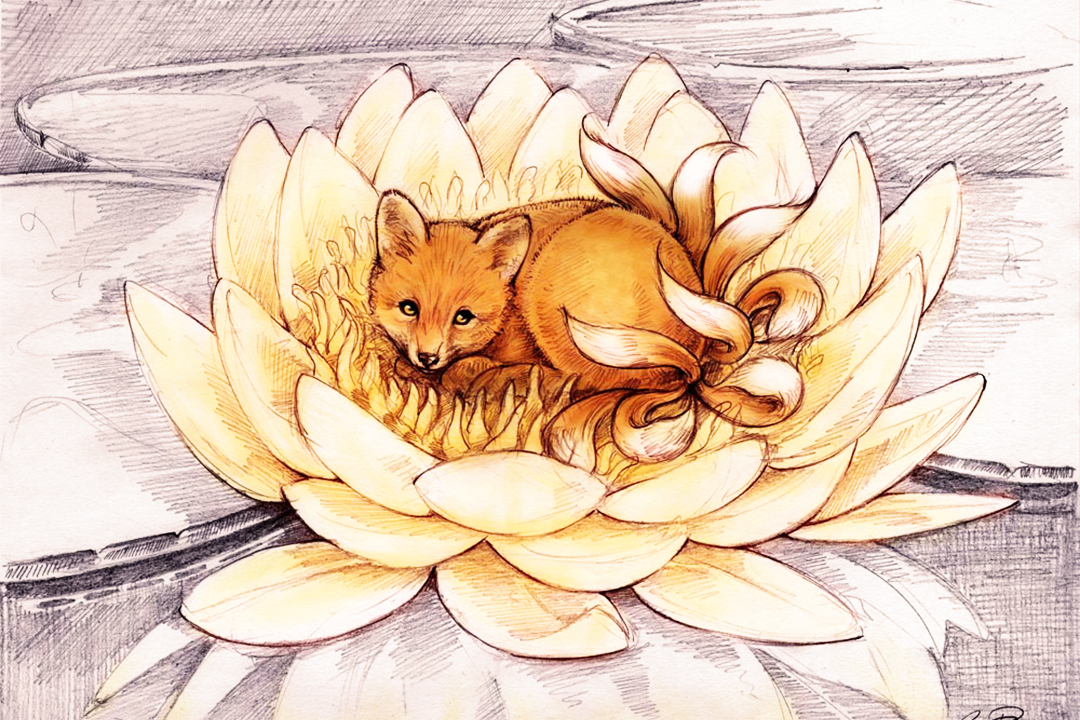
As the tale goes
The world Kitsune does not literally mean ‘Fox’. Kitsu was the word used to indicate the sound emitted by these animals. In ancient Japanese, Kitsu-ne meant “that comes back and sleeps”, or it could also be read as ki-tsune, “that always comes back” The explanation for these interpretations can be give by one of the many legends about these spirits.
The most ancient one goes like this:
«Ono, an inhabitant of Mino (says an ancient Japanese legend of A.D. 545), spent the seasons longing for his ideal of female beauty. He met her one evening on a vast moor and married her. Simultaneously with the birth of their son, Ono's dog was delivered of a pup which as it grew up became more and more hostile to the lady of the moors. She begged her husband to kill it, but he refused. At last one day the dog attacked her so furiously that she lost courage, resumed vulpine shape, leaped over a fence and fled.
"You may be a fox", Ono called after her, "but you are the mother of my son and I love you. Come back when you please; you will always be welcome".
So every evening she stole back and slept in his arms.»
(From the tale It comes back and sleeps written by monk Kyoukai in late VIII s. Or in the beginning of IX s.)
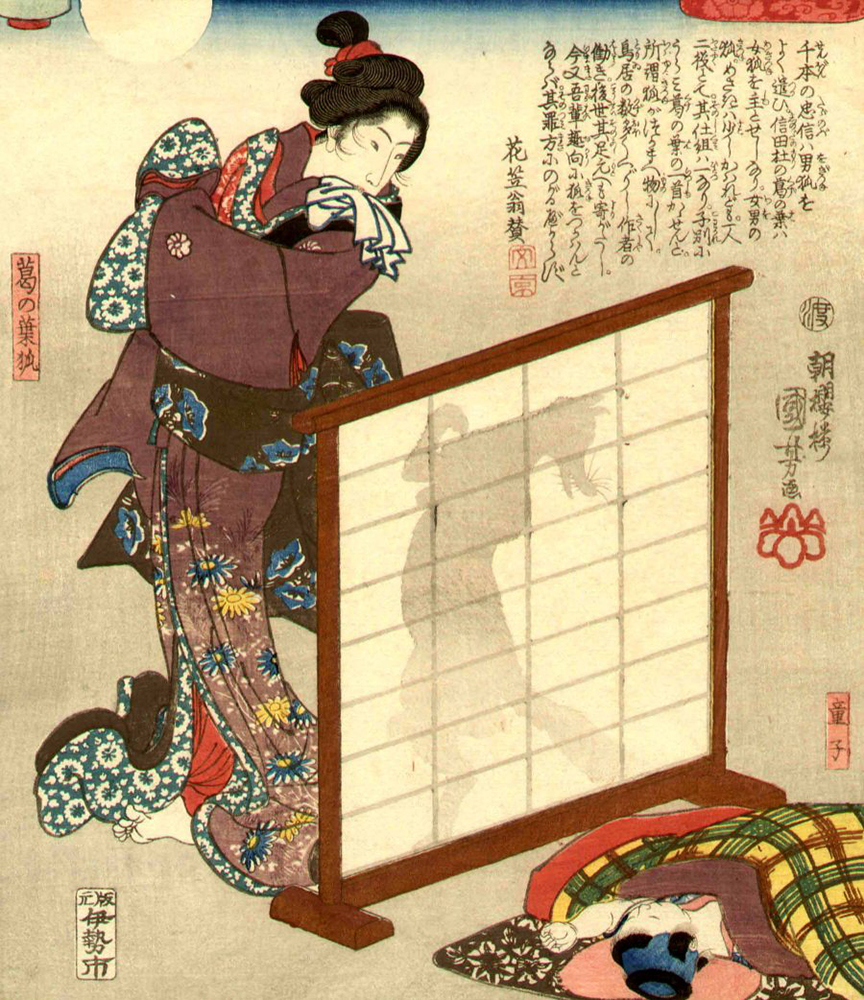
A dualist being
As mentioned, they are shapeshifting spirits and they have the ability to turn without age or sex problems. Their most famous and undoubtedly fascinating figure is that of a beautiful young woman. In fact Kitsune-gao (狐 顔 "fox face") is a term used to describe feminine features. High cheekbones and fine and narrow eyes, considered to be very sensual. According to tradition it is believed that seeing a beautiful woman wandering aimlessly during sunset hours it could actually be a fox.
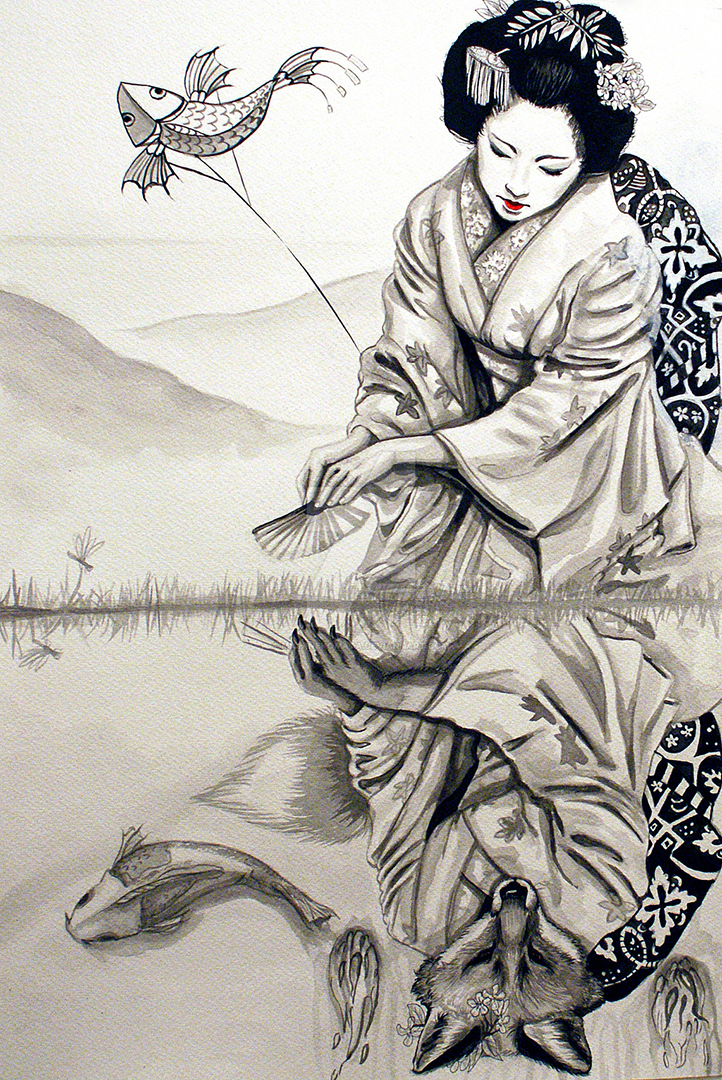
In order to discover their true nature we must find the tail as the Kitsune can not disguise it. Alternatively, you should be loyal people but also their dislike for dogs can be a signal. Loyal animals can perceive their true being. Sometimes in their malignant form, the Kitsune draw strength and power from her lover. They absorb their energies through sexual intercourse and dry up the human forces and gruesomely causing death.
There are several shrines dedicated to Inari, their protector. It's usual to find depictions of these animals around the temples. The most well known is the Fushimi Inari Taisha shrine dedicated to the gods located in Kyoto. Also present in Buddhism, we find Dakini, Inari's female alter ego, as she rides a white fox, brandishing a sword. In these temples, the faithful are used to leave offerings of food for them, udon, soba, sushi and preferably the Aburaage fried tofu which is said to be Kitzune's favourites.
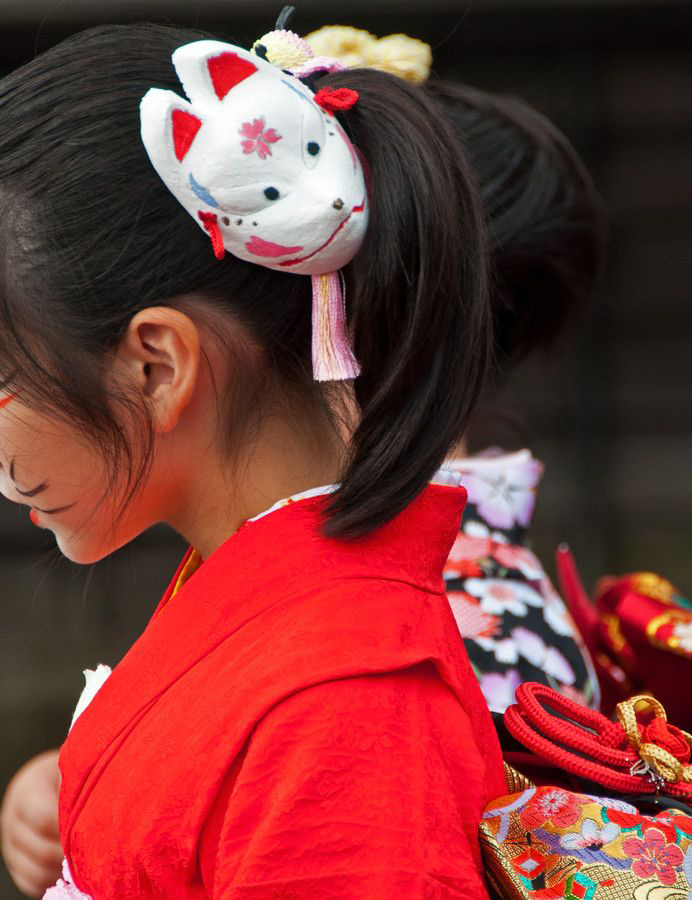
From the tradition to the animation
They are undoubtedly loved creatures in Japan. They are on traditional masks used in theatrical plays, in many variants: Gin-tenko / Silver fox, Kinko/ Golden fox, Hakuko/ the White fox, and many more.
The netsuke are the small statues made in wood or ivory. They are used as coin-purses to decorate kimonos, and are normally seen in popular mangas or anime. The most famous anime of the past few years is Naruto. Here the young ninja Naruto has the spirit of a fox sealed inside his body. This animal can be recognised in his personality, in his physical aspect, and in his powers too. We can find a fox in Inuyasa too. Here Shippo is a small demon fox that always creates funny gags changing his appearance.

Also, in the character of Kurama, from Yū Yū Hakusho, we find a fox spirit that was reborn in the human form of Shuichi Minamino. In this last character it extremely visible the dualistic nature of these spirits. On one side, the good-natured human being, devoted to his mother and loyal to his friends, on the other side, the cruel and unaffected fox spirit.
But these are just a few examples of how kitsunes have influenced the world of the animation. In Shiroichi, in the Tohoku region (north Japan), we can find the Miyagi Zao Fox Village. This is a faunistic park where it is possible to meet these lovely animals in their natural environment. Here you can see how friendly they can be and it's really easy to take pictures or even interact with them.
Festivals, Parades
Obviously, in a country so in love with traditions like Japan, there are numerous festivals dedicated to foxes too. The Kitsunebi matsuri, ‘The Festival of the Fire Fox’, is celebrated on the forth Saturday of September in the vicinity of the Okura Inari sanctuary of Hida. On this occasion, people create a masked parade, a sort of rappresentation of the so called ‘Marriage of the fox’, to invite good luck. During the New Year celebrations, in Kita (special ward of Tokyo) takes place the parade of the foxes of Ōji. During this event, everyone disguise as foxes and go to the Ōji Inari. This parade is inspired by the legend that tells how foxes all around Japan gather around a tree disguised as humans to celebrate the New Year and then reach the nearby sanctuary.
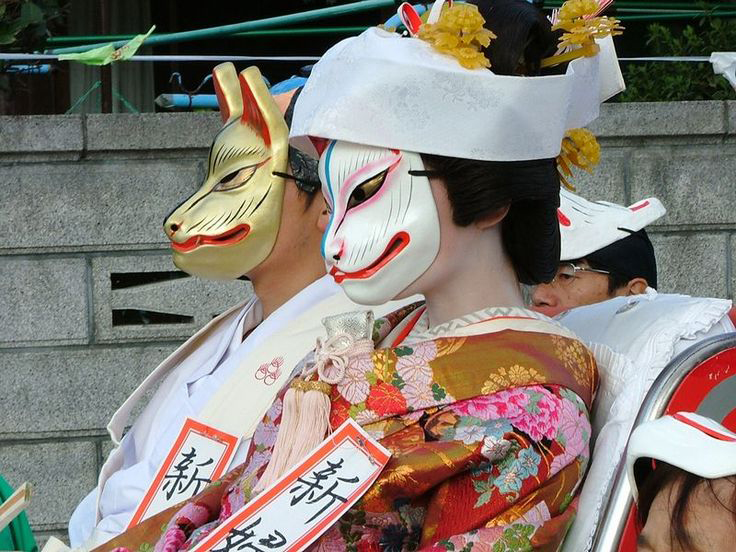
Marriage
We also have the saying Kitsune no Yomeiri (狐の嫁入り "the marriage of the foxes"). During the night foxes gather together, and in a line one behind the other, travel for rivers and mountains with lanterns made of paper to celebrate their marriages. An exception to this legend is Tokushima where it is believed that this is a funeral procession. According to Japanese people, if outside is raining but there is the sun too, then it means that foxes are celebrating a marriage.
This way of thinking changes from area to area. For example, in Ehime it happens when it is snowing, while in Kumamoto when there is the rainbow.
Nonetheless, with this atmospheric phenomenons it's not so uncommon to see small glittering lights. Those lights are the lanterns of the foxes. When you see something like this, pay attention, you might be able to see the marriage of the foxes!
Photo credits: tokyobling; mangadreams; pinterest; deviantart.









